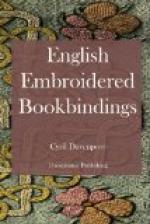It occurs again largely on another small New Testament, printed in 1640, bound in white satin, measuring 4-1/2 by 2-1/4 inches; now in the British Museum. In this case the artist has not attempted the difficult task of producing a satisfactory figure in needlework, but has very properly limited her skill to the reproduction of flower and animal forms. On the upper cover is a spray of columbine, the petals of which, pink and blue, are each worked separately in needlepoint lace stitch, and afterwards tacked on to a central rib. The stalks and leaves of this spray are also worked in needlepoint, and on the top sits a bullfinch, worked in many colours in the same way, but fastened down close to the satin all round. In the corners are a beetle, a nondescript flower, a bud, and a butterfly with coloured wings in needlepoint, with replicas of them closely appliques just underneath, on the satin. On the lower board is a spray of a five-petalled blue flower, the petals of which were originally worked in needlepoint and fastened on a central rib, but they have now all gone except two, leaving the rib of thick pink braid. The supporting replicas underneath are, however, perfect, showing what the original upper petals were like. This spray has two leaves, exquisitely worked in needlepoint, and fastened by a stitch at one end, with the usual flat replicas underneath them, and there is also a bud. The stem is a piece of green braid. Above the spray is a parrot in needlepoint, most of him fastened down round the edges, but his wings and tail left free. In the upper corner are two strawberries, and in the lower a butterfly, with coloured wings, left free in needlepoint. There are also two caterpillars on this side.
On the back are three large flowers heavily worked in silk and metal threads, in needlepoint, and appliques—a pansy, lily, and rose, with stalks of green braid. The boards are edged all round with a gold braid, and there are two green silk ties on each for the front edges. There are several gold spangles all about, but many more have gone. The work on both boards is very delicate, but that on the back is curiously coarse. Such imitative work as the needlepoint, which is perhaps seen at its best in the columbine, and the leaves on this book, is at all times a dangerous thing to use, except when it is only used as applique, as in the beautiful cover belonging to this book, which I have described on page 18, and the work on which is very likely by the same skilled hand as that on the book. I believe this use of the needlepoint, or button-hole stitch, is only found in English work; it is exactly the same as is used on the old Venetian and other so-called ‘point’ laces, but executed in fine-coloured silk instead of linen thread, and without open spaces.
[Illustration: 48—Psalms. London, 1641.]
Psalms. London, 1641.
Nicholas Ferrar’s establishment at Little Gidding in Huntingdonshire is often credited with having produced embroidered books, but there is really no authority for the belief. All the authentic bindings which came from Little Gidding have technical shortcomings from a bookbinding point of view, none of which are found on any embroidered books.




